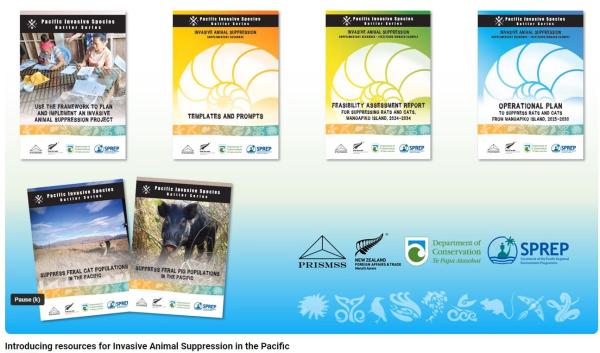
The Pacific Regional Invasive Species Management Support Service (PRISMSS) and the New Zealand Department of Conservation (DOC) have launched new ‘Battler’ invasive animal suppression resources and an online training video.
Invasive animals have devasting effects on the biodiversity of Pacific islands. Rats and cats’ prey upon native birds, reptiles, and small mammals. Pigs and goats disrupt ecosystems, causing soil erosion and nutrient imbalances through their digging, trampling, and browsing.
Impacts are detrimental to local communities, leading to economic losses, food scarcity, and health risks as diseases are spread to humans and animals.
Climate change increases these impacts – invasive animals that flourish in altered climate conditions are expected to increase their damage, further threatening regional prosperity.

David Moverley, Invasive Species Adviser from the Secretariat of the Pacific Regional Environment Programme (SPREP), a lead organisation of PRISSMS, says practitioners at all levels can use the Battler resource, from beginners to mentors.
“Beginners are encouraged to follow the resources’ framework step by step. Experienced predator control practitioners will find value in the templates and other tools that make it easier to achieve their goals.
“Important additions to the Battler resource include publications on suppressing feral cat and feral pig populations in the Pacific.”
“Methods in the Battlers are tried and tested. Several pilot sites have had very successful outcomes with increases in threatened endemic birds, such as the kākerōri bird in Rarotonga which increased from 29 individuals in 1989 to over 470 birds in 2017.
DOC’s Director Terrestrial Biodiversity, Hilary Aikman, says DOC is proud to support invasive species suppression in the Pacific in collaboration with PRISMSS, Secretariat of the Pacific Regional Environment Programme (SPREP) and New Zealand’s Ministry of Foreign Affairs and Trade.
“The Pacific region's native biodiversity has evolved over millennia and is truly extraordinary. Effective suppression of invasive species is critical to saving some of the world most endangered birds, such as the kacau ni Gau of Fiji, which only has a population of 30-100 individuals.
“We are excited about the future projects these resources will support and hope they will assist programmes that enhance lives and natural environments in the Pacific region,” Hilary Aikman says.
The Battler package is available online through the Battler Resource Base.
PRISMSS will continue to work closely with partners and stakeholders to battle invasive species and provide the necessary tools and resources.
Media contacts:
PRISMSS: Nitish Narayan, Communications & Liaison Officer, SPREP – [email protected]
DOC: [email protected]
Pacific Regional Invasive Species Management Support Service (PRISMSS)
PRISMSS facilitates the scaling up of invasive species management in the Pacific and brings together experts to provide support within the Pacific region with a focus on protection of indigenous biodiversity and ecosystem function. As a service provider, PRISMSS provides a comprehensive suite of support services to Pacific Island countries and territories.
The PRISMSS Resilient Ecosystems, Resilient Communities programme, led by the Secretariat of the Pacific Regional Environment Programme (SPREP) Invasive Species Team, BirdLife International with the assistance of NZDOC, integrates community involvement in ecological restoration, ensuring that resilient ecosystems provide direct benefits to local communities. By managing invasive species and reintroducing native species, we create sustainable environments where both nature and people thrive together.